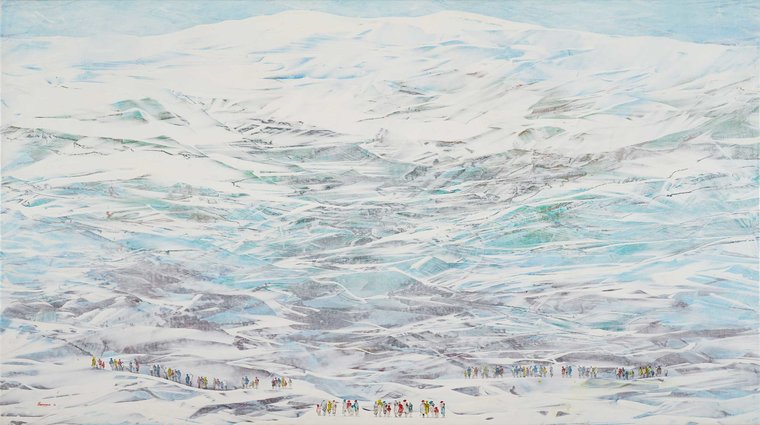The Wedding of Earth to Sannine captures a mountain’s intertwined ridges draped with an untainted coat of snow. In the foreground, lines of human stick figures, dwarfed by the landscape, stand gazing at the vast expanse of natural scenery, their backs to the viewer. Part of the “Peace in Waiting” exhibition, depicting a series of landscapes featuring Mount Sannine, the painting is an ode to Lebanese painter Chaouki Chamoun’s persistently vivid memory of his childhood. Having grown up in the village of Sariine, facing the east side of the majestic mountain in the Mount Lebanon range, Chamoun has repeatedly portrayed Sannine, and been inspired by it.
Chamoun’s admiration for Mount Sannine is not the only recurrent element in his paintings. A varying position of caricature human figures has become his signature mark present in most of his work. In The Wedding of Earth to Sannine the miniature figures appear in a state of reverie, seemingly waiting for something. They stand frozen in the presence of the imposing mountain as if watching a performance or viewing a work of art. The wait represents our state of existence. The all-encompassing experience of life is depicted amid an all-embracing blanket of white snow. The allegory undeniably points to the peace that could be had in waiting, as the name of the exhibition alludes to. Taken together, the series of paintings unfold into a narrative. They become a set of shifting topographies that tell a story, with the mountain as its main character.
The story of The Wedding of Earth to Sannine is undoubtedly that of beautiful contrasts.
At first glance, the sheer size of Sannine relative to the composition could be perceived as overwhelming, almost threatening. However, the tiny lines of people that frame the lower register of the painting create a commanding contrast. Chamoun uses a soothing color palette of white, grey, and blue to depict the peaceful yet omnipresent mountain; the colors stand in stark contrast with the vivid figures at the mountain’s foot. Furthermore, Chamoun paints the figures’ frocks in bright heterogenous red, yellow, and blue tints. This mix of color denotes the diversity of individual human experiences, as all face a more uniform, steadfast natural world.
When the painting is looked at closely, Chamoun’s distortion of scale – the Sannine mountain vs. the tiny figures- is amplified further by his use of a large horizontal canvas. This makes viewers feel like they have shrunk before the painting’s sight. Consequently, the beauty of the natural world above and beyond its potential ruthlessness is emphasized.
The work is, furthermore, rife with symbolism that invites viewers to rejoice and accept the human experience with serenity rather than restlessness. The snow depicted in the painting is commonly used as an allegory for purity. It "covers sadness in the eyes of the earth," as the artist asserts. The snow conveys a sense of harmony between Sannine and Earth, wedding them to one another. Sannine is painted as a bride in pure white, with the snow gently lying over rugged earth. The intermarriage between masculine and feminine is an allusion to the title of the painting, conveying a message of celebration and unity.




